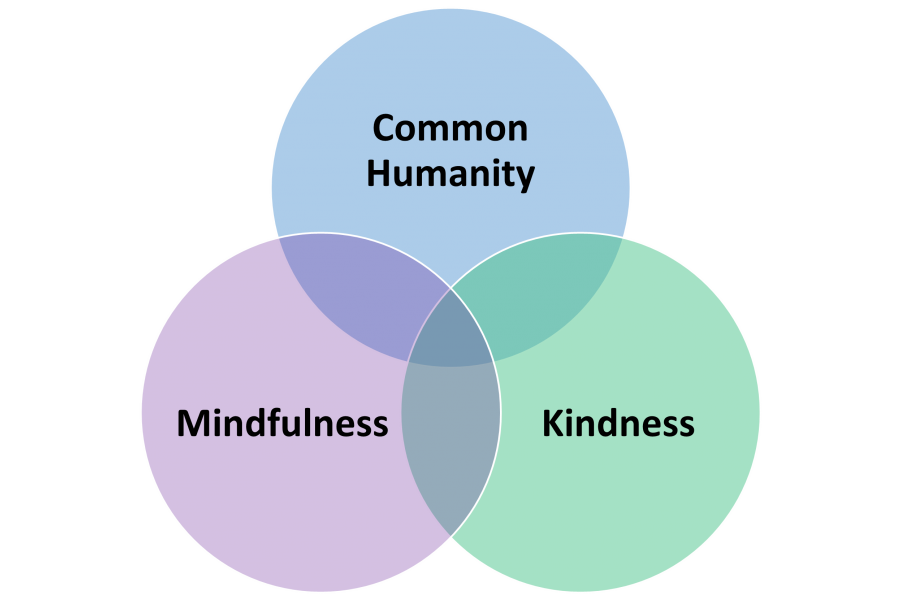How we process
- Observing and sitting with our emotions
- We are not our emotions
- Opposite: over-identification
The University of Manitoba campuses and research spaces are located on original lands of Anishinaabeg, Ininiwak, Anisininewuk, Dakota Oyate, Dene and Inuit, and on the National Homeland of the Red River Métis. More
University of Manitoba
Winnipeg, Manitoba Canada, R3T 2N2
Supporting the well-being of instructors and students has become a key priority in moving forward toward a sustainable model of education that continues to be academically rigorous while respecting the growing diversity in who our students are, why they are seeking advanced learning, and what that learning can mean for their futures.

As with many other facets of our lives, the COVID-19 pandemic brought to light stressors in post-secondary education that have been accumulating for many years. Supporting the well-being of instructors and students has become a key priority in moving forward toward a sustainable model of education that continues to be academically rigorous while respecting the growing diversity in who our students are, why they are seeking advanced learning, and what that learning can mean for their futures.
Compassionate pedagogy is one of a number of approaches, including pedagogies of kindness (Denial, 2018; Rawle, 2021), care (Stommel, 2021; Bali, 2021), and healing (Imad, 2021), that explore and imagine a future for faculty and students that moves away from what Dickson and Summerville describe as a paradigm of suffering in academia:
By adopting a compassionate stance, faculty and instructors can move towards teaching and learning practices that are flexible, equitable, and sustainable for themselves and their students.
This article outlines a place to start in connecting a compassionate approach to your classroom:
Compassion can be defined as understanding that all humans experience times of suffering and being ready and willing to help relieve that suffering.
Compassion, while being emotionally motivated, is also an action. Jazaieri (2017) identifies four key components in compassion: a cognitive component in the awareness of suffering; an affective component in being moved by suffering; an intentional component in wishing to relieve suffering; and a motivational component in being ready to take action.
Compassion can be directed inward (self-compassion) or outward to another/others. There are similarities in how compassion is given to both self and to another, however it is important to note that these are two separate skills that require their own practice.
By enhancing your self-compassion, you can develop an appreciation for the elements of a compassionate approach and create a strong and sustainable foundation for practicing compassion towards others.
Self-compassion is treating oneself in the same way you would a loved one or close friend—in essence, extending compassion to yourself when you are suffering. Neff (2021; n.d.) and her collaborators have developed an extensive body of research in this area, with a self-compassion framework emphasizing three elements of practice: common humanity (as opposed to isolation); mindfulness (as opposed to over-identification); and kindness (as opposed to self-judgment).
Being self-compassionate positively impacts:
If you are interested in exploring your current stance towards self-compassion, Neff’s Self-Compassion Test is available online for some additional guidance.

Many faculty and instructors are already incorporating elements of what would be seen as a compassionate approach: one that balances academic rigour with well-being for all involved in the learning process.
Some values and approaches for fostering a compassionate culture that you may already emphasize and can continue to grow are:
The self-compassion framework provides one possible access point into organizing a model of compassionate pedagogy. By focusing on the three areas of common humanity, mindfulness, and kindness, instructors can explore teaching and learning approaches that respect the whole person, while focusing on areas of compassionate action that are appropriate to their specific classroom and disciplinary context.

Like everyone, students live in a world-at-large where they face a variety of challenges. Recent research on Canadian university students found:
Many of these numbers predate the COVID-19 pandemic which brought additional changes, uncertainty, and complexity into our lives. A mindset grounded in common humanity can remind us that poor academic performance, trouble concentrating, and classroom behaviours that may be labelled as disruptive do not usually stem from an attempt by the student to be difficult, but rather as a symptom of suffering experienced in the course of daily challenges that may at times become overwhelming. Common humanity invites instructors to do what we can about the teaching and learning environment to respect the whole student.

Mindfulness is the practice of being present in each moment. In the context of compassion it is a reminder to be intentional and engaged in preparing to teach, in reactions while teaching, and in reflecting on teaching.


When adopting a new approach or practicing an unfamiliar skill, remember to exercise self-compassion—it may take time, patience, and some experimentation to start feeling comfortable!
ACHA [American College Health Association]. (2019). American College Health Association-National College Health assessment II: Canadian reference group data report spring 2019. American College Health Association. https://www.cacuss.ca/files/Research/NCHA-II%20SPRING%202019%20CANADIAN%20REFERENCE%20GROUP%20DATA%20REPORT.pdf
Agger, L. O.. (2020). Namegosibiing Anishinaabe compassion: A cure for modern day ills [Master’s thesis, University of Manitoba, Master of Arts]. mSpace. https://mspace.lib.umanitoba.ca/xmlui/handle/1993/34659
Bluth, K., & Neff, K. (2018). New frontiers in understanding the benefits of self-compassion. Self and Identity. http://www.tandfonline.com/action/showCitFormats?doi=10.1080/15298868.2018.1508494
Burczycka, M. (2020). Students’ experiences of discrimination based on gender, gender identity or sexual orientation at postsecondary schools in the Canadian provinces, 2019. Statistics Canada. https://www150.statcan.gc.ca/n1/en/pub/85-005-x/2020001/article/00001-eng.pdf?st=1AS0Htd_
Dickson, L., & Summerville, T. (2018). 'The truth about stories': Coming to compassionate pedagogy in a first-year program. Journal of Perspectives in Applied Academic Practice, 6(3), 24-29. https://jpaap.ac.uk/JPAAP/article/view/378/505
Fraser, E. (2018, November 19). Homelessness among university students bigger than people realize. CBC News. https://www.cbc.ca/news/canada/new-brunswick/student-homelessness-university-of-new-brunswick-1.4911095
Imad, M. (2021, July 8). Pedagogy of healing: Bearing witness to trauma and resilience. Inside Higher Ed. https://www.insidehighered.com/views/2021/07/08/how-faculty-can-support-college-students%E2%80%99-mental-health-fall-opinion
Janowick, J. (2020, May 13). Pedagogy of kindness [Video]. https://cte.openlcc.net/learningtogether/2020/05/04/pedagogy-of-kindness/
Jazaieri, H. (2018). Compassionate education from preschool to graduate school: Bringing a culture of compassion into the classroom. Journal of Research in Innovative Teaching & Learning, 11(1), 22-66. doi:10.1108/JRIT-08-2017-0017
Neff, K. (n.d.). Definition of self-compassion. Retrieved July 21, 2022 from https://self-compassion.org/the-three-elements-of-self-compassion-2/
Neff, K. (2021). Fierce self-compassion: How women can harness kindness to speak up, claim their power, and thrive. Harper Wave.
Overgaard, C., & Mackaway, J. (2021, March 4). Kindness as push-back and designing for care. Teche. Macquarie University. https://teche.mq.edu.au/2021/03/kindness-as-push-back-and-designing-for-care/
Rawle, F. (2021, August 20). A pedagogy of kindness: The cornerstone for student learning and wellness. The Times Higher Education. https://www.timeshighereducation.com/campus/pedagogy-kindness-cornerstone-student-learning-and-wellness
Sing, N. (2021, October 7). The fight to end hunger on Canadian university campuses. Maclean’s. https://www.macleans.ca/education/the-fight-to-end-hunger-on-canadian-university-campuses/
Stommel, J. (2021, October 1). Start by trusting students start by trusting teachers [Presentation slides]. Presentation given to The Hub for Teaching and Learning, University of Michigan – Dearborn. https://dearbornhub.net/?p=1147
Trust, T. (n.d.). Humanizing online/remote classes [infographic]. Retrieved August 4, 2022 from https://www.torreytrust.com/design-projects